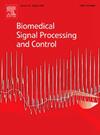一种基于图的脊柱分割方法:结合目标检测和无监督分割
IF 4.9
2区 医学
Q1 ENGINEERING, BIOMEDICAL
引用次数: 0
摘要
脊柱图像分割对于脊柱疾病的诊断和治疗具有重要意义。然而,在没有分割标签的情况下,从脊柱图像中自动分割椎骨和椎间盘是一个具有挑战性的问题。在本文中,我们提出了一个端到端的脊柱图像分割框架来实现脊柱图像的自动分割。该框架包括初始化阶段、粗分割阶段和细分割阶段。初始化阶段是一个训练好的感兴趣区域检测器。粗分割阶段是一个深度自编码器聚类网络。在此阶段,利用的重构损失和聚类损失来实现无监督粗分割。此外,还采用了固定通道策略,在保证分割性能的同时,大大减少了模型参数的数量。在精细分割阶段,从图结构的角度对图像分割进行重新解释。从粗分割的边缘像素被用来构造图。图注意机制充分考虑了节点的特征和节点间的边缘特征,实现了无监督精细分割。在两个脊柱图像分割数据集和一个脑肿瘤图像分割数据集上的实验表明,该方法具有较好的性能和泛化能力。本文章由计算机程序翻译,如有差异,请以英文原文为准。
A graph-based spine segmentation method: Combining target detection with unsupervised segmentation
Spine image segmentation is important for the diagnosis and treatment of spinal diseases. However automatic segment vertebrae and intervertebral discs from spine images without segmentation labels is a challenging. In this paper, we propose an end-to-end spine image segmentation framework to achieve automated spine image segmentation. The framework consists of an initialization stage, a coarse segmentation stage and a fine segmentation stage. The initialization stage is a trained regions of interest detector. The coarse segmentation stage is a deep autoencoder clustering network. In this stage, the reconstruction loss and clustering loss of is used to achieve unsupervised coarse segmentation. In addition, a fixed number of channels strategy is also employed to greatly reduce the number of model parameters while ensuring the segmentation performance. In the fine segmentation stage, the image segmentation is reinterpreted from the perspective of the graph structure. The edge pixels from the coarse segmentation are used to construct graphs. The features of the nodes and the features of the edges between nodes are fully considered by the graph attention mechanism to achieve unsupervised fine segmentation. Experiments on two spine image segmentation datasets and one brain tumor image segmentation dataset show that our method has superior performance and generalization ability.
求助全文
通过发布文献求助,成功后即可免费获取论文全文。
去求助
来源期刊

Biomedical Signal Processing and Control
工程技术-工程:生物医学
CiteScore
9.80
自引率
13.70%
发文量
822
审稿时长
4 months
期刊介绍:
Biomedical Signal Processing and Control aims to provide a cross-disciplinary international forum for the interchange of information on research in the measurement and analysis of signals and images in clinical medicine and the biological sciences. Emphasis is placed on contributions dealing with the practical, applications-led research on the use of methods and devices in clinical diagnosis, patient monitoring and management.
Biomedical Signal Processing and Control reflects the main areas in which these methods are being used and developed at the interface of both engineering and clinical science. The scope of the journal is defined to include relevant review papers, technical notes, short communications and letters. Tutorial papers and special issues will also be published.
 求助内容:
求助内容: 应助结果提醒方式:
应助结果提醒方式:


